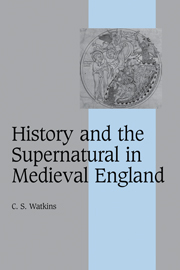Book contents
- Frontmatter
- Contents
- Preface
- Note on the text
- List of abbreviations
- INTRODUCTION
- Chapter 1 THINKING ABOUT THE SUPERNATURAL
- Chapter 2 INVENTING PAGANS
- Chapter 3 PRAYERS, SPELLS AND SAINTS
- Chapter 4 SPECIAL POWERS AND MAGICAL ARTS
- Chapter 5 IMAGINING THE DEAD
- Chapter 6 THINKING WITH THE SUPERNATURAL
- CONCLUSION
- Bibliography
- Index
- Cambridge Studies in Medieval Life and Thought Fourth Series
INTRODUCTION
Published online by Cambridge University Press: 23 June 2009
- Frontmatter
- Contents
- Preface
- Note on the text
- List of abbreviations
- INTRODUCTION
- Chapter 1 THINKING ABOUT THE SUPERNATURAL
- Chapter 2 INVENTING PAGANS
- Chapter 3 PRAYERS, SPELLS AND SAINTS
- Chapter 4 SPECIAL POWERS AND MAGICAL ARTS
- Chapter 5 IMAGINING THE DEAD
- Chapter 6 THINKING WITH THE SUPERNATURAL
- CONCLUSION
- Bibliography
- Index
- Cambridge Studies in Medieval Life and Thought Fourth Series
Summary
The history of religious culture in medieval England has been dominated in recent decades by studies dealing variously with the early missions and the Pre-Reformation church. The intervening period, especially that from c.900 to c.1200, has been the subject of rather less attention. The reasons for this are not hard to find. For historians of Anglo-Saxon religion the business of Christianisation can be seen as substantially complete by the early tenth century. Monastic reform and the ‘Normanisation’ of the church in England both form important historiographical pendants to narratives of Anglo-Saxon religious change, but in both cases the story has tended to be one of politics, institutions and ‘high’ cultural exchange. Revisionist interpreters of the Reformation meanwhile have inevitably concentrated on the fourteenth and fifteenth centuries in their efforts to rescue late medieval Catholicism from the condescension of Protestant posterity. Historians so engaged have stretched back to the thirteenth century where early forms of later offices and institutions such as churchwardens and chantries are dimly visible, but they seldom reached out deeper into time. Such reluctance is in part a result of scarce resources: the rich harvest of fifteenth-century evidence – wills, letters, churchwardens' accounts, visitation returns, sermons, instruction manuals, church art and objects – is wholly vanished or much diminished by the time we get back to the twelfth. Julia Smith has put the perceived problem in a nutshell: ‘there simply is not adequate evidence to pursue the questions that interest historians of lay religiosity before c.1200’.
- Type
- Chapter
- Information
- History and the Supernatural in Medieval England , pp. 1 - 22Publisher: Cambridge University PressPrint publication year: 2007

